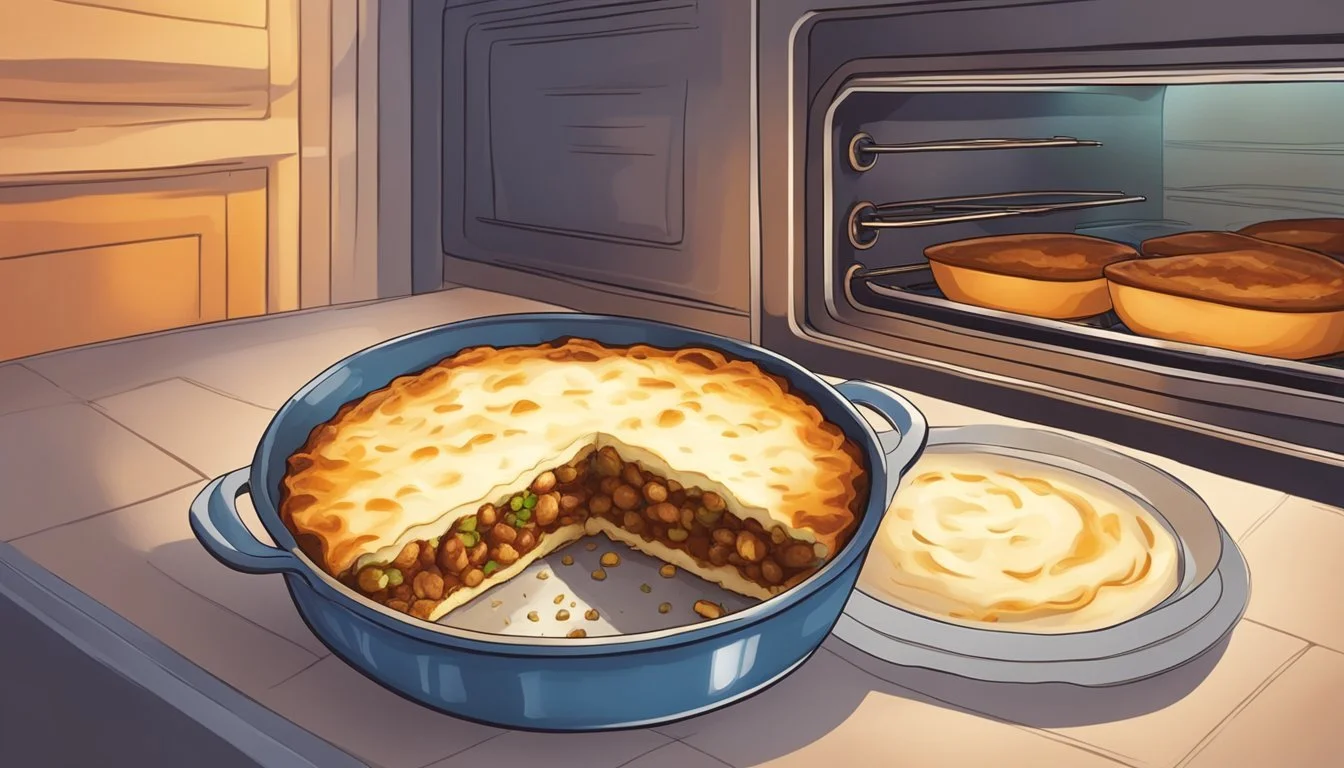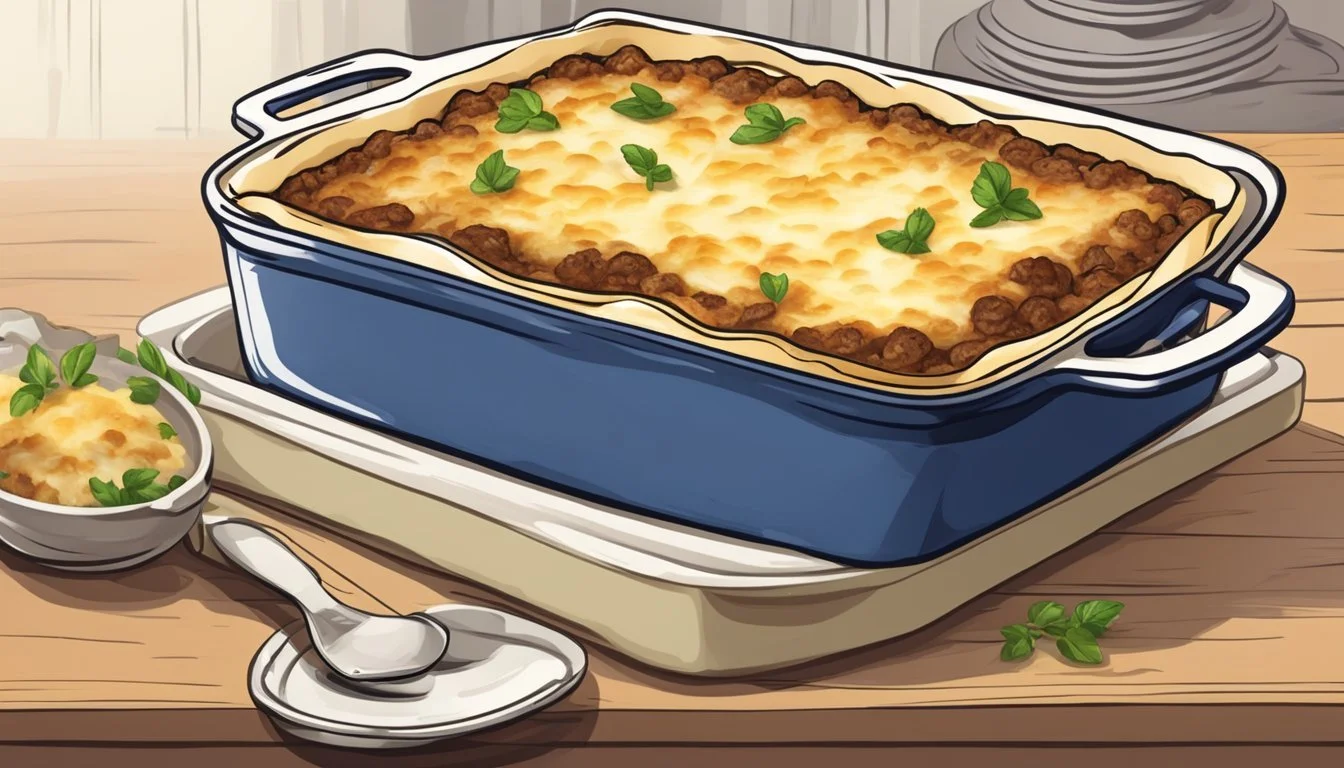Best Way to Reheat a Moussaka Without Separating the Béchamel
Expert Tips for a Perfect Dish
Reheating moussaka, a traditional Mediterranean layered casserole, so that the creamy béchamel sauce maintains its texture and doesn't separate, is a simple yet delicate process. A properly reheated moussaka should warm through to the center without drying out or causing the rich, custard-like top layer to split. Such precision ensures the dish retains its intended flavors and textures, which can be especially challenging when working with components as sensitive as béchamel sauce.
To achieve this, one should heat the dish evenly at a moderate temperature. A common recommendation for reheating moussaka is to use an oven heated to 350°F (about 177°C), covering the baking dish to trap steam and prevent the moussaka from drying out. It's essential that the moussaka reaches the appropriate internal temperature to ensure it is heated through without adversely affecting the béchamel. A gentle and controlled reheating process preserves the culinary integrity of this beloved dish, serving up a taste as close to fresh as possible.
Understanding Moussaka
Moussaka is a quintessential Greek dish notable for its layered combination of eggplants (What wine goes well with eggplant?), sliced potatoes, and a savory meat sauce, topped with a rich béchamel that lends a creamy finish.
Key Ingredients
Moussaka brings together a range of flavors and textures that are central to its identity:
Eggplant (What wine goes well with eggplant?): Often the star layer, eggplant is sliced and traditionally either fried or broiled, contributing to moussaka's unique texture and taste.
Meat: Typically ground lamb or beef is seasoned with spices and layered in moussaka to add a rich, savory depth.
Potatoes: Sliced and layered at the base, they provide a firm foundation, absorbing flavors and adding their own subtle taste.
Tomatoes: Fresh or pureed, tomatoes contribute to the moisture and acidity of the meat sauce.
Cheese: Varieties such as kefalotyri or pecorino can be sprinkled atop the béchamel or within layers for a salty, tangy element.
Olive Oil: Used in cooking eggplants and meat, this heart-healthy oil is a staple in Mediterranean cuisine and moussaka’s cooking process.
Béchamel Sauce: This white sauce made from flour, butter, and milk is spiced with nutmeg and sometimes enriched with egg yolks or cheese; it forms a creamy, custard-like layer that browns beautifully upon baking.
Traditional Moussaka Culinary Techniques
The preparation of moussaka employs several techniques essential for achieving its authentic flavor:
Seasoning and Cooking Meat: Meat is browned, drained of excess fat, and simmered with spices, wine, and tomato to create a rich sauce.
Preparing Eggplant: Eggplant slices are often salted, rinsed, dried, and then fried or broiled until softened and lightly browned.
Layering: Moussaka is then assembled in layers—starting with potatoes, followed by eggplant, meat sauce, and finally topped with béchamel sauce.
Baking: The entire ensemble is baked until the béchamel forms a golden crust, signaling the moussaka is ready to be served.
The Role of Béchamel in Moussaka
Béchamel sauce is not merely a topping; it plays a critical role in moussaka:
Moisture Balance: It helps maintain the dish's moisture during cooking and as it is reheated.
Structural Integrity: Upon cooling, béchamel sets into a semi-solid state, helping to keep the layers distinct and making moussaka easier to cut and serve.
Flavor Enhancer: Béchamel adds a creamy, rich layer of flavor that melds the spices and ingredients into a harmonious whole.
Each layer in moussaka serves a particular purpose, not only in terms of flavor but also in terms of texture and structural integrity. The béchamel sauce, in particular, is indispensable for a perfectly balanced moussaka.
Pre-Reheating Steps
To ensure that your leftover moussaka is heated through evenly and the béchamel sauce remains creamy, certain pre-reheating steps are pivotal. Proper storage and preparation can make the difference between a deliciously refreshed meal and a disappointing one.
Storage Tips for Leftover Moussaka
One must take care when storing leftover moussaka to maintain its quality. The dish should be allowed to cool to room temperature before being placed in the refrigerator, to prevent bacterial growth. It's essential to store the moussaka in a sealed container or wrap it tightly with foil to avoid exposure to air, which can dry it out. If stored properly in the fridge, moussaka can typically maintain its quality for up to 3-4 days.
Preparing the Moussaka for Reheating
Before reheating, the moussaka should be taken out of the fridge and allowed to come to near room temperature — this helps in even reheating. Preheat your oven to 350°F (175°C). If the moussaka has been kept in individual pieces, they should be placed in an oven-safe dish, maybe with a light brushing of olive oil to prevent sticking. If the moussaka was refrigerated as one large piece, one should simply cover the dish with foil, which aids in heating without drying out the top layer.
Reheating Moussaka in the Oven
When reheating moussaka in the oven, the main goal is to ensure the dish is heated through while maintaining the integrity of the béchamel sauce. Precision with temperature and covering the dish properly are crucial steps.
Step-by-Step Oven Reheating Instructions
Preheat the oven to a moderate temperature of 350°F (177°C) to avoid shocking the béchamel with high heat.
Transfer the leftover moussaka into an oven-safe baking dish if it is not already in one.
Cover the dish with foil to create a protective barrier that will help to retain moisture and evenly distribute heat.
Reheat the moussaka for approximately 20-30 minutes. Keep an eye on it to ensure it doesn't overcook, especially if it's in individual portions which may require less time.
Check the internal temperature by inserting a clean knife into the center of the moussaka. It should feel hot to the touch.
How to Prevent Béchamel from Separating
Oil: Lightly brushing the surface of the béchamel with a thin layer of olive oil can prevent drying and cracking during reheating.
Temperature: Keep the temperature steady at 350°F (177°C); béchamel sauce can separate under sudden high temperatures.
Foil: Sealing the dish with foil keeps the moisture locked in and prevents the top layer from separating or becoming rubbery.
Baking Time: Monitor the moussaka closely to avoid excessive heating, which can cause the béchamel to break down. Less time in the oven reduces this risk.
Alternative Reheating Methods
When reheating moussaka, maintaining the texture and flavor of the béchamel sauce is paramount. Two effective methods, using a microwave and reheating on the stove, can achieve satisfactory results if done carefully.
Using a Microwave
Reheating moussaka in a microwave is convenient for individual portions. To start, one should transfer the leftover moussaka into a microwave-safe container. It's important to cover the container with a microwave-safe lid or a piece of cling wrap with a few holes poked in to allow steam to escape. This helps to keep the moussaka moist. Heat the moussaka at medium power in 30-second intervals, stirring gently after each interval to ensure even reheating. It's vital to avoid overheating, as this can cause the béchamel to separate or become oily.
Reheating on the Stove
For those preferring not to use a microwave, reheating moussaka on the stove is a feasible alternative. Place the moussaka in a pan and cover it with a lid to help retain moisture. Heat it on a low heat to allow the moussaka to warm up slowly and evenly. This method reduces the risk of separating the béchamel sauce. The gentle heat will warm the dish without drying it out or altering its flavor profile, but it is generally more time-consuming than microwaving.
Enhancing Moussaka Flavors Post-Reheat
After carefully reheating moussaka to ensure the béchamel layer remains intact, the focus shifts to enhancing the dish's flavors. One can reintroduce freshness and vibrancy to the dish by incorporating new ingredients and pair moussaka with side dishes that complement its rich taste.
Adding Fresh Ingredients
To rejuvenate the taste of moussaka post-reheat, one might consider adding a drizzle of high-quality extra virgin olive oil, which can add a fruity and peppery note. A sprinkle of fresh oregano leaves can brighten up the dish considerably, balancing the richness of the meat and béchamel sauce. Additionally, garnishes such as freshly grated nutmeg or black pepper can enhance the depth of flavor.
Pairings and Side Suggestions
Moussaka, with its savory layers, is a fulfilling meal on its own, but complementary sides can elevate the dining experience. Serving a Greek salad on the side not only adds a crisp texture contrast but the tangy and fresh flavors can cut through the richness of the moussaka. Another excellent pairing is tzatziki, a refreshing yogurt-based sauce infused with cucumber and garlic. It adds a cooling element which can balance the spices such as cinnamon found within moussaka.
Special Tips and Considerations
In reheating moussaka, one must navigate maintaining the integrity of the béchamel sauce and ensuring that the dish's layers do not separate. Paying attention to specific reheating techniques, dietary variations, and preparation stages is crucial for preserving this comfort food's luscious texture and flavors.
Vegetarian and Vegan Variations
For a vegetarian moussaka, one can simply substitute the traditional meat layer with a rich mixture of lentils or mushrooms. While reheating, it’s essential to prevent the béchamel from separating, which can be achieved by reheating the dish gently in the oven and ensuring that the béchamel contains a stabilizer like flour.
Regarding vegan variations, utilize plant-based milk and cheese for the béchamel. For an authentic taste, select vegan parmesan cheese or other grated cheese alternatives with sufficient melting properties. Perform gentle reheating to retain the cream-like consistency of the vegan béchamel without curdling.
Freezing and Thawing Recommendations
To freeze moussaka, ensure it has completely cooled before wrapping it securely to avoid freezer burn.
Steps to Freeze:
Cool the moussaka.
Wrap in airtight packaging.
Place in the freezer.
For thawing, transfer the moussaka to the refrigerator 24 hours before reheating. This slow thaw prevents sudden temperature changes that could split the béchamel.
Serving Moussaka to Guests
One must take special care when serving moussaka to guests. First, segment the moussaka into individual servings while it’s cold, reducing the risk of crumbling under heat. Once segmented:
Oven Reheating for Guests:
Preheat oven to 350°F (177°C).
Arrange portions in an oven-safe dish.
Cover with foil to retain moisture.
Heat until the internal temperature reaches 165°F.
This approach ensures each serving is heated through while the béchamel sauce stays intact, offering guests a spectacularly warm and comforting experience.
Final Thoughts
Reheating moussaka while preserving the integrity of its béchamel topping is crucial to enjoying this traditional Mediterranean dish. Leftover moussaka still offers a delightful savory experience when appropriate reheating techniques are used.
When reheating, one must ensure the temperature is moderate—usually around 350°F (175°C)—to prevent the béchamel from separating and the moussaka from drying out. It should be heated slowly and evenly, which might take longer than other dishes, but patience is key to preserving its flavors and textures.
In terms of preparation, covering the moussaka with foil can aid in even heat distribution and retain moisture. If a microwave is the only option, reheating in short intervals on medium heat, while keeping the dish covered to allow steam to escape, is the next best approach.
Remember, a moussaka recipe is more than just a set of instructions; it is a reflection of a rich culinary tradition. By employing careful preparation and reheating methods, one can ensure that the reheated moussaka closely resembles its freshly baked counterpart, thus honoring its traditional roots.
Finally, serving reheated moussaka immediately ensures that it retains its heat and the flavors remain robust. Such attentiveness to reheating will ensure that the dish remains a beloved staple, embodying the essence of Mediterranean comfort food.







